BibTex format
@article{Hughes:2007:10.1177/1479972307084446,
author = {Hughes, JMB},
doi = {10.1177/1479972307084446},
journal = {Chron Respir Dis},
pages = {205--214},
title = {Assessing gas exchange.},
url = {http://dx.doi.org/10.1177/1479972307084446},
volume = {4},
year = {2007}
}

